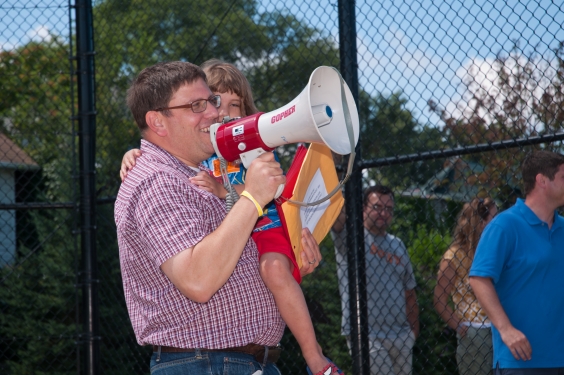Joe Cimperman: Ward 3's Welcoming Councilman

Joe Cimperman at Near West Recreation this summer
Ohio City's past is a vibrant quilt of history and quirk. After all, this is a place where a long-shuttered bank reemerged as the most elegant dining room in town, where a dismal array of dark storefronts now sells everything from cigars to popcorn and where the city's only modern hostel occupies a century building that was once home to the Victor Tea Company.
What might the year 2020 look like in this rapidly evolving neighborhood?
To answer that question, Ohio City Argus sat down with Ward 3 Councilperson Joe Cimperman, on whom the local history is not lost. The ongoing status of the neighborhood also looms large for this Clevelander who resides with his family on West 45th Street. His vision of the area follows an arc that doesn't simply amble down the frenetic entertainment district surrounding West 25th Street, but instead focuses on Ohio City's long standing tradition of caring for its people.
"In a neighborhood like Ohio City, its magic is in how the neighborhood continues to become more of what it is even as everything seems to change," says Cimperman, who calls institutions such as the May Dugan Center and St. Patrick's Parish "critical to the DNA of the neighborhood." He looks to the future with loving eyes, but not through rose-colored glasses.
"I see the future as brighter than ever," says Cimperman, citing area job growth and an unprecedented interest in Ohio City's residential areas. "I also see it as more challenging."
Those challenges bloom in contrast: While dozens of finance professionals work at the United Bank Building and Hingetown begins to shimmer and crackle, the neighborhood's diverse population includes Jesuit volunteers, a notable senior citizen population and a large contingent for which English is a second language.
"We can't forget them," insists Cimperman. "At the same time, economic development equals safety. Job growth equals security. Occupying buildings that were vacant means less opportunity for bad things to happen. We have to remember that balance." To achieve that, says Cimperman, means employing simple yet fundamental human courtesies. "We have to respect each other. We have to listen to each other. We have to move forward."
With those mantras as guidelines, the six-term councilman offers an inspiring vision of Ohio City in the years to come with tolerance as its centerpiece. Cimperman's desires for the area are so lofty and passionate, they dwarf today's squabbles (which he vows will be resolved) over parking at the Market and Golden Arches on Lorain.
"I want Ohio City to be a neighborhood where kids can get an education from the time they're born until they're ready to go to college," he says, adding that he hopes the Ohio City of tomorrow will have more bicycles than cars and residents in every house.
"I want to live in a neighborhood where people who are African American feel comfortable living next to people who are gay, living next to people who come from Syria, who all feel that they have more in common than they don’t," he says, adding that he hopes Ohio City will be a place of many languages, welcoming immigrants and migrants and refugees, and a place where people recognize that "who's coming next" is almost as important as who is here today.
"I want to live in a neighborhood where people recognize that institutions like Lutheran Hospital, St. Ignatius, the West Side Market—and yes—CMHA play a vital and critical role to all of our health," he says, regardless of a person's health status or religious beliefs or shopping habits or whether or not they've ever needed public housing.
"Mostly," says Cimperman, "I want to live in a neighborhood where we can all say—as we draw our last breath—that we did everything we could to make our brothers and sisters feel that this was their home too."
Cimperman's palpable conviction for Ohio City's future goes hand in hand with his involvement with the Healthy Cleveland Initiative, in which the city has partnered with area hospitals to promote healthy diet, exercise and nonsmoking as well as mental health. Regarding implementation in Ohio City, Cimperman cites the Go! Foods® program at Dave's Supermarket, free area tai chi classes for seniors, mental health services at Lutheran Hospital, plans to address damaged sidewalks (in an effort to promote walking clubs) and a no-smoking policy in parks and public places.
"Interestingly enough," says Cimperman, "it's the residents who are enforcing the law. When people light up, (others) point to signs that say it's illegal to smoke in the park."
Ultimately, Cimperman hopes the collaborative efforts will improve the quality of life in Ohio City and increase the life expectancy of its residents. "That will be how we determine if we have succeeded or failed."
He's betting on the former, because the odds—at least from where Cimperman's standing in the heart of Ohio City—are pretty good, maybe even better than good.
"It's happening," he says, adding that the neighborhood is already evolving as an engaged community that attends church, rails against what it opposes and rallies for what it supports. "I say to people, 'you don’t have to believe what I’m telling you. You should believe your eyes.'"
